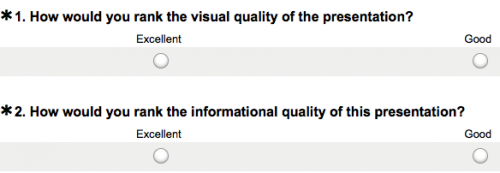
Image Credit:
Screenshot via SurveyMonkey
*The final unit of my RHE 309K: Rhetoric of Animal Rights course features an oral presentation based around a multimedia advocacy project that each student must design. As the major part of the evaluation, I create and use online polls (using tools such as SurveyMonkey and Qualtrics) that the students complete in real time after every presentation. Each poll asks four trait-centered questions, followed by a holistic evaluation, allowing for a variety of data combinations to see how students respond to each other’s work. Polls can be more elaborate than this, naturally, but the point here is to capture initial impressions while the memory is still fresh.
Students are familiar with polls, of course, as they not only complete a course survey evaluating their instructors and teaching assistants, but also are asked to fill out an exit poll for a wide array of campus services. Using polls in the classroom no doubt predates computer-assisted instruction, and could certainly still be done without it, but computers provide a number of services that pencil-and-paper methods would not, such as multiple permutations and combinations of the data. They also allow for total anonymity of response, generally a good thing for any democratic evaluation.
Technological convenience aside, however, using polls in determining grades seems a subset of a larger pedagogical problem: the ethics of peer evaluation. It’s easy to anticipate a response both from students and other educators something like, “well, you’re the one getting paid here; farming out evaluation is at best lazy and at worst negligent.”
But I disagree with this, for three overlapping reasons. First, one of the central problems that we face as rhetorical educators is getting past the single-audience problem. By this, I mean the idea that the only purpose of college writing is to crack the teacher’s code, to figure out what she wants to hear, and to write it. When I tell students that the persuasive appeal of the final oral presentation is aimed at the rest of the class, online polling shows that I mean it.
Second, as Peter Elbow tells us, teachers are not the typical readers that most writing in the world encounters. Fellow students provide a diversity of perspectives and concerns that are far more representative of a typical public discourse’s audience than the one I offer. If activism is more than an academic exercise, then other voices ought to count.
Finally, students are more discerning than I would have initially thought. Sure, they grade each other a bit more kindly than I do, but ultimately the ordinal rankings that they produce in terms of best and worst performances end up looking very similar to mine. They can tell when someone hasn’t done his homework. Hearing that from a peer is, ultimately, probably a bigger stick than hearing from the teacher.
*As many of my blogging ideas do, the idea of crowd-sourced grading grew in part from a conversation with DWRL Assistant Director Beck Wise.
